Andrea Doria (1/7)
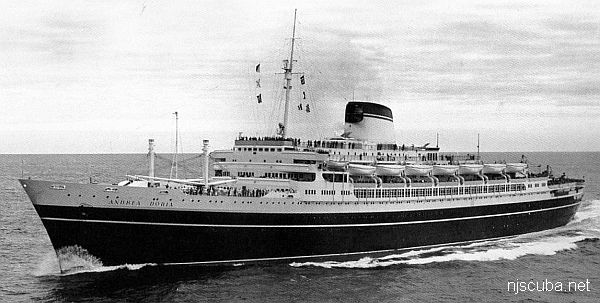

- Type:
- shipwreck, liner, Italy
- Name:
- A 16th century Genoese Admiral. This name had been previously carried by a number of Italian warships ( see page bottom )
- Built:
- 1951, Italy
- Specs:
- ( 700 x 90 ft ) 29083 displacement tons, 1706 passengers & crew
- Sunk:
- Thursday July 26, 1956
collision with freighter Stockholm ( 12000 tons) - 46 casualties - GPS:
- 40°29.405' -69°52.028' (AWOIS)
- Depth:
- 240 ft ( 190 ft minimum )
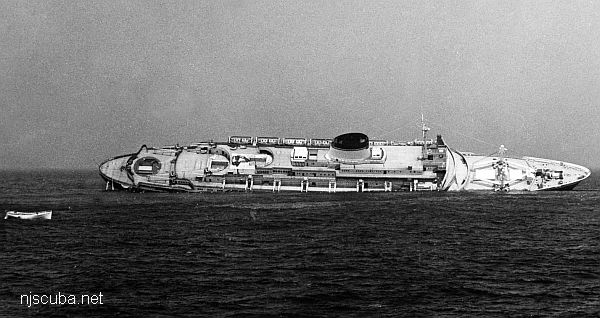
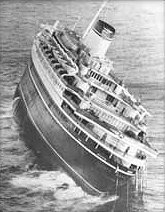

The collision between the Andrea Doria and the Stockholm has been studied and debated for over 50 years. For the collision, both ships are at fault, with the Stockholm probably bearing more of the blame. Both ships made a series of wrong moves that ultimately made the collision unavoidable, from going too fast in fog to not following accepted 'rules of the road'. The Andrea Doria's radar picked up the Stockholm 17 miles out, and it made no difference. The Stockholm likewise had the Doria on radar, but her radar operator misread his set.

In fact, the Andrea Doria was not hit that badly by the much smaller Stockholm, and should not have sunk. The real reason for the sinking was that the Doria and her sisters were deficient in stability, making them far more susceptible to rolling. Sister ( and replacement ) Leonardo da Vinci later had 3000 tons of iron ballast set into her bilges in an attempt to correct this. They were opulent ships, which also contributed to their top-heaviness. In addition, their watertight bulkheads were not tall enough, and could be over-topped by a 20 degree list. Finally, the Doria was arriving in New York with near-empty fuel tanks, and the Captain had chosen not to ballast the empty tanks with seawater. The bow of the Stockholm was reinforced for ice and made a perfect battering ram.
The result of these combined factors is that a relatively minor hit from the Stockholm punched a neat hole into the Doria's empty starboard fuel tanks, which flooded immediately. The list of the ship quickly increased to the point that the seawater intakes on the other side came up out of the water and counter-flooding became impossible, yet another defect in her design. ( Apparently, there were no cross-connections, another design flaw. ) At the same time, it became impossible to launch half the lifeboats. The list eventually exceeded the maximum for the water-tight bulkheads, and the entire ship began to flood. Fortunately, it took 11 hours for the doomed ship to sink, and everyone was safely evacuated except those that were killed in the actual collision.
One must remember that the Andrea Doria was designed in the age of slide-rules. They had no computers or computer modeling. Ship design was very much a matter of estimating how all that metal would float and move, based mainly on previous experience. In the case of the Andrea Doria, previous experience failed. It's not that they didn't know how to design a big ship - the pre-war Rex was much bigger than the Andrea Doria class. My guess is that the designers traded-off stability for fuel-efficiency, but they they traded-off more than they intended. Even today, with computer-aided-design, things can come out wrong. The Nimitz-class supercarriers all have a permanent list to starboard, the side with the island.
Ship design is a mass of trade-offs. For example, increasing the height of the heavy water-tight bulkheads would increase the top-weight of the ship, decreasing its stability, and you could actually end up worse-off. The one thing that could have been done was to ballast down the empty fuel tanks with seawater. The hole from the Stockholm's bow would have had much less effect if the tanks were already full of water on both sides, and the Doria probably would have just limped into New York and been repaired. Why didn't Captain Calamai do that? Because the tanks need to be pumped out before they can be refilled with fuel, and the contaminated seawater dealt with, and that costs money. Also, a light ship that is not as deep in the water burns less fuel. And finally, he wasn't expecting to get in a collision, who does?
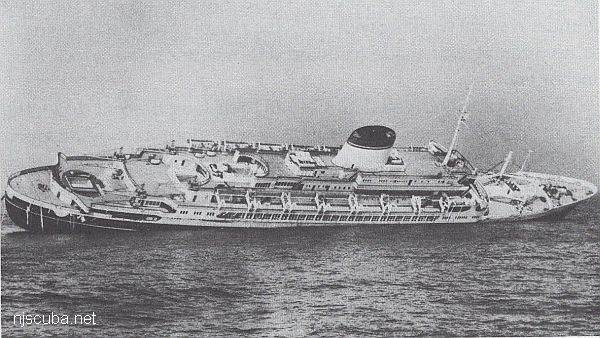
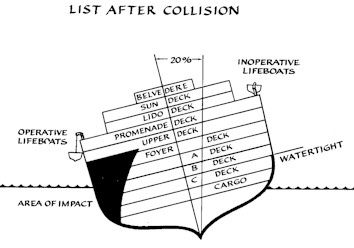
The diagram above neatly sums up the problems with tha Doria's design. It shows the inadequate height of the watertight bulkheads and the list that the ship took on almost immediately owing to its deficient stability. It also shows how the lifeboats on one side would have been difficult to use, while those on the other side were impossible. It was the flooded fuel tanks that caused the initial list, but that was not enough flooding to sink her. She stayed afloat for 11 hours because the compartments of the hull would have flooded sequentially outward from the point of impact, each one only beginning to flood when its neighbor became full and overtopped the bulkhead.
There may also have been watertight doors open or missing, but that would not have affected the ultimate outcome. If the fuel tanks had been properly ballasted with seawater, just one compartment would have flooded, and the ship would have settled on an even keel and sailed into New York for repairs. If the bulkheads had been taller, again, just one compartment would have flooded.
It seems to me that the Andrea Doria was sunk by her designers and her Captain. The failure of the counter-flooding system is to me as an engineer, simply incredible. The lack of cross-connects renders the system useless just when it is needed. The Andrea Doria was not a warship, and I wouldn't expect that degree of damage control, but she had no effective counter to the flooding she experienced.
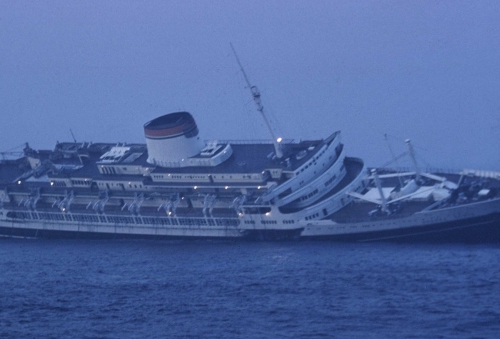
Strong currents, extreme depths, and the distance from land and medical facilities have always made diving the Andrea Doria a hazardous endeavor. It is even more so today.
The Doria is not the dive that it used to be. The hull is collapsing badly, and the top of the wreck is now below 190 ft. Many of the places that divers used to visit have deteriorated beyond recognition. Gimbel's hole, once the famous entry to the inside of the wreck, is now no more than a closed-off depression. Every year, as the hull sinks further into itself, the dive becomes deeper, more dangerous, and more pointless. Once the "Mount Everest of Shipwreck Diving", the heyday of the Andrea Doria is over. I have never been there, and have no desire to go, but I know a lot of people who have, including some of the most experienced.
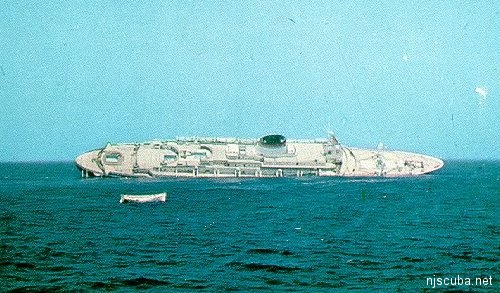





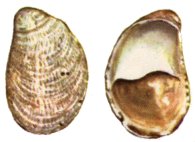
Greg Hacus:
May 5, 2022 at 2:42 pm
Very entertaining and informative read. I am not a diver but I love ships and reading about dives on wrecks. I read this at work and could not walk away. I learned a lot about diving reading your exploits. Very interesting!! great job on stories , pictures, everything four stars!!!